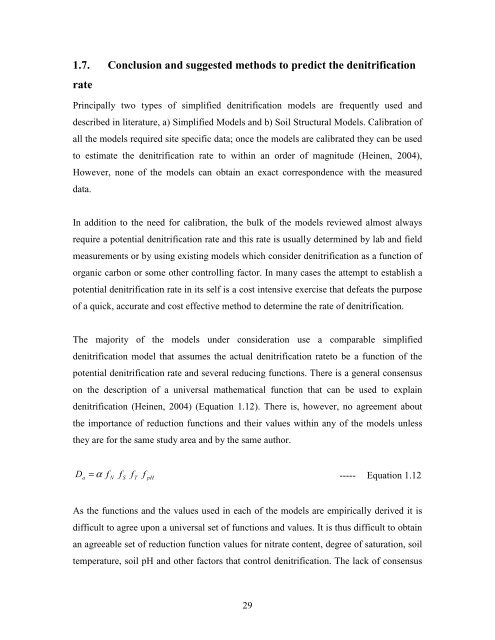THE FLORIDA STATE UNIVERSITY ARTS AND SCIENCES ...
THE FLORIDA STATE UNIVERSITY ARTS AND SCIENCES ...
THE FLORIDA STATE UNIVERSITY ARTS AND SCIENCES ...
Create successful ePaper yourself
Turn your PDF publications into a flip-book with our unique Google optimized e-Paper software.
1.7. Conclusion and suggested methods to predict the denitrification<br />
rate<br />
Principally two types of simplified denitrification models are frequently used and<br />
described in literature, a) Simplified Models and b) Soil Structural Models. Calibration of<br />
all the models required site specific data; once the models are calibrated they can be used<br />
to estimate the denitrification rate to within an order of magnitude (Heinen, 2004),<br />
However, none of the models can obtain an exact correspondence with the measured<br />
data.<br />
In addition to the need for calibration, the bulk of the models reviewed almost always<br />
require a potential denitrification rate and this rate is usually determined by lab and field<br />
measurements or by using existing models which consider denitrification as a function of<br />
organic carbon or some other controlling factor. In many cases the attempt to establish a<br />
potential denitrification rate in its self is a cost intensive exercise that defeats the purpose<br />
of a quick, accurate and cost effective method to determine the rate of denitrification.<br />
The majority of the models under consideration use a comparable simplified<br />
denitrification model that assumes the actual denitrification rateto be a function of the<br />
potential denitrification rate and several reducing functions. There is a general consensus<br />
on the description of a universal mathematical function that can be used to explain<br />
denitrification (Heinen, 2004) (Equation 1.12). There is, however, no agreement about<br />
the importance of reduction functions and their values within any of the models unless<br />
they are for the same study area and by the same author.<br />
D = α f f f f<br />
----- Equation 1.12<br />
a<br />
N<br />
S<br />
T<br />
pH<br />
As the functions and the values used in each of the models are empirically derived it is<br />
difficult to agree upon a universal set of functions and values. It is thus difficult to obtain<br />
an agreeable set of reduction function values for nitrate content, degree of saturation, soil<br />
temperature, soil pH and other factors that control denitrification. The lack of consensus<br />
29
















